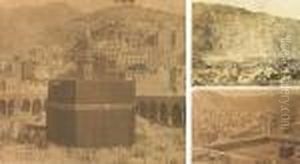Muhammad Sadiq Bey Paintings
Muhammad Sadiq Bey was an Egyptian army officer, photographer, and one of the pioneers of photography in Egypt. Born in 1830 in Cairo, he was a man of diverse interests and talents, who lived through a period of significant change in Egypt, witnessing its modernization efforts under the rule of Khedive Ismail.
Sadiq Bey joined the Egyptian army and rose to the rank of Colonel. His military career allowed him to travel, and it was during these travels that he developed an interest in photography. In the mid-19th century, photography was still a relatively new invention, and Sadiq Bey became one of the first Egyptians to explore its potential. He was not only interested in the technical aspects of photography but also saw its value as a means of documentation and communication.
As a photographer, Sadiq Bey was particularly known for his portraits and landscapes. He captured images of notable figures of the time, as well as everyday people, offering a unique glimpse into 19th-century Egyptian society. His work is significant for its early adoption of the medium in the region and for the historical insight it provides.
Sadiq Bey was also a member of several international photography societies, through which he gained recognition for his contributions to the field. He participated in various exhibitions, including the 1867 Universal Exhibition in Paris, where he presented his photographs of Egypt, its people, and its landscapes.
His works are considered important historical documents, as they provide a visual record of Egypt during a time of transformation from a traditional society to a more modern state under European influence. The photographs of Muhammad Sadiq Bey thus hold both artistic and documentary value, providing a window into the past for historians and art enthusiasts alike.
Muhammad Sadiq Bey passed away in 1902, leaving behind a legacy as one of the early adopters and practitioners of photography in the Middle East. His photographs continue to be studied and appreciated for their historical significance and contribution to the field of photographic art.
